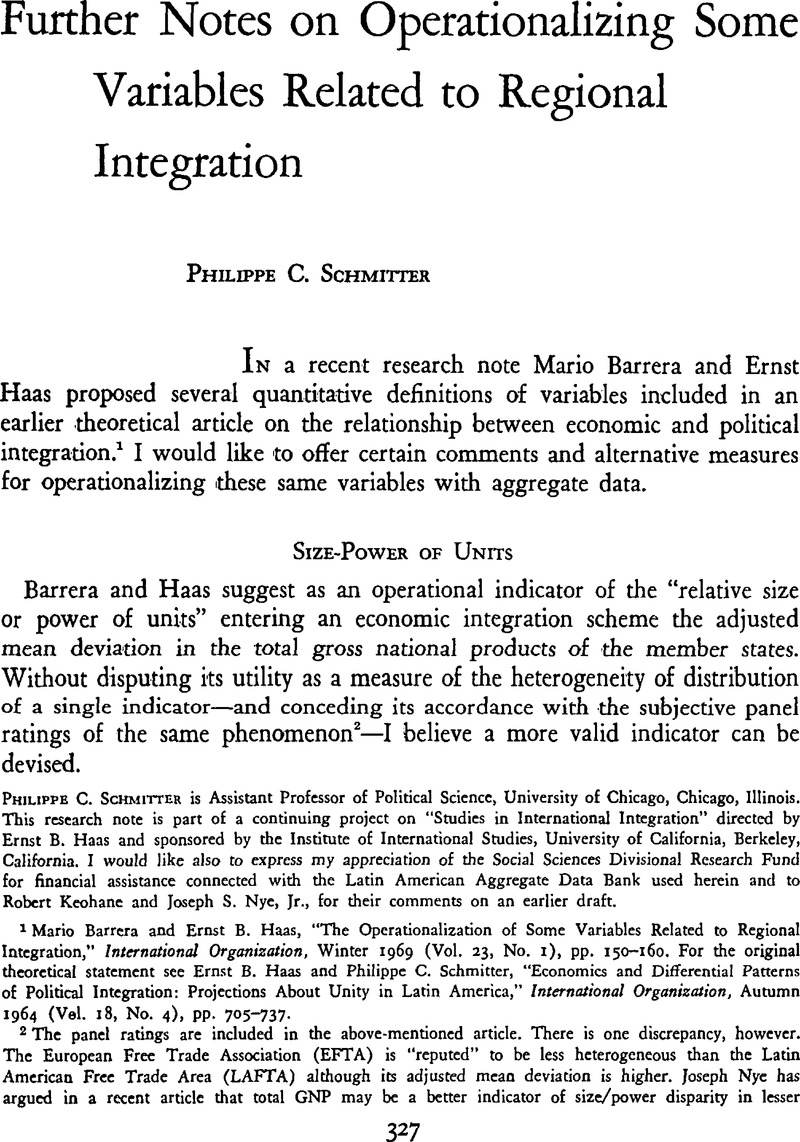Article contents
Further Notes on Operationalizing Some Variables Related to Regional Integration
Published online by Cambridge University Press: 22 May 2009
Abstract

- Type
- Notes on Theory and Method
- Information
- Copyright
- Copyright © The IO Foundation 1969
References
1 Barrera, Mario and Haas, Ernst B., “The Operationalization of Some Variables Related to Regional Integration,” International Organization, Winter 1969 (Vol. 23, No. 1), pp. 150–160CrossRefGoogle Scholar. For the original theoretical statement see Haas, Ernst B. and Schmitter, Philippe C., “Economics and Differential Patterns of Political Integration: Projections About Unity in Latin America,” International Organization, Autumn 1964 (Vol. 18, No. 4), pp. 705–737CrossRefGoogle Scholar.
2 The panel ratings are included in the above-mentioned article. There is one discrepancy, however, The European Free Trade Association (EFTA) is “reputed” to be less heterogeneous than the Latin American Free Trade Area (LAFTA) although its adjusted mean deviation is higher. Joseph Nye has argued in a recent article that total GNP may be a better indicator of size/power disparity in lesser rather than more developed settings. (Nye, Joseph S. Jr, “Comparative Regional Integration: Concept and Measurement,” International Organization, Autumn 1968 [Vol. 22, No. 4], p. 878CrossRefGoogle Scholar.)
3 For an extended discussion and operationalization of various evaluative criteria in international ranks see Schwartzman, Simon and Araujo, Manuel Mora y, “The Images of International Stratification in Latin America,” Journal of Peace Research, 1966 (No. 3), pp. 225–243CrossRefGoogle Scholar.
4 Siegel, Sidney, Nonparametric Statistics for the Behavioral Sciences (New York: McGraw-Hill, 1956), p. 230Google Scholar
The formula for calculating ![]()
I thank my colleague, E. Wood Kelly, for suggesting this measure in place of the more laborious one I originally intended to use–the average value of the Spearman rank coefficients between all possible ranks.
5 See Russett, Bruce and others, World Handbook, of Political and Social Indicators (New Haven, Conn: Yale University Press, 1964)Google Scholar; and Gurr, Ted, New Error-Compensated Measures for Comparing Nations: Some Correlates of Civil Violence (Research Monograph No. 25.) (Princeton, N.J: Center of International Studies, Woodrow Wilson School of Public and International Affairs, Princeton University, 1966)Google Scholar.
6 Cf. Haas, Ernst B. and Schmitter, Philippe C., The Politics of Economics in Latin American Regionalism: The Latin American Free Trade Association After Four years of Operation (Monograph Series in World Affairs, Vol. 3, Monograph No. 2) (Denver, Colo: Social Science Foundation and Graduate School of International Studies, University of Denver, 1965–1966)Google Scholar; Schmitter, Philippe C., “The Process of Integration in Central America: Spill-over or Spill-around?” (paper presented at the American Political Science Association Convention, Chicago, 09 1967)Google Scholar.
7 Reinton, Per Olav, “International Structure and International Integration,” Journal of Peace Research, 1967 (No. 4), pp. 334–365CrossRefGoogle Scholar. For discussions of other transnational-transactional indicators see Nye, pp. 855–880; see also Angell, Robert C., “The Growth of Transnational Participation,” Journal of Social Issues, 01 1967 (Vol. 23, No. 1), pp. 108–129CrossRefGoogle Scholar.
8 See Banks, Arthur S. and Textor, Robert B., A Cross-Polity Survey (Cambridge, Mass: M.I.T. Press, 1963)Google Scholar.
9 I have questioned this elsewhere. See my “New Strategies for the Comparative Analysis of Latin American Politics” (paper presented at the Latin American Studies Association meetings, New York, 11 1968), pp. 7–12Google Scholar.
10 Cf. “Development, Political Groups and Interest Politics,” Chapter I in Schmitter, Philippe C., Development and Interest Politics in Brazil: 1930–1965 (forthcoming from Stanford University Press)Google Scholar.
11 Gibbs, Jack and Martin, Walter, “Urbanization, Technology and the Division of Labor: International Patterns,” American Sociological Review, 10 1962, pp. 667–677Google Scholar; Olsen, Marvin, “Multivariate Analysis of National Political Development” (unpublished manuscript, Indiana University, 1968)Google Scholar. The figures in the tables (except for Guatemala which is my calculation) are Olsen's.
12 In Table III, I have not deducted from the total foreign trade dependence figure that proportion of it which is exchanged with regional “partners.” Since it is the latter sort of interdependence which regional economic integration seeks to promote (and which is measured in the transactions variable) only dependence upon outsiders, especially upon great-power trading partners, should be included.
13 Cf. Hudson, Michael C., “Some Quantitative Indicators for Explaining and Evaluating National Political Performance” (paper presented at the American Political Science Association Convention, Chicago, 09 1967)Google Scholar.
14 In his above-cited paper Hudson suggests the multiple of foreign trade times military expenditures as the indicator of “external political stress.”
- 18
- Cited by




